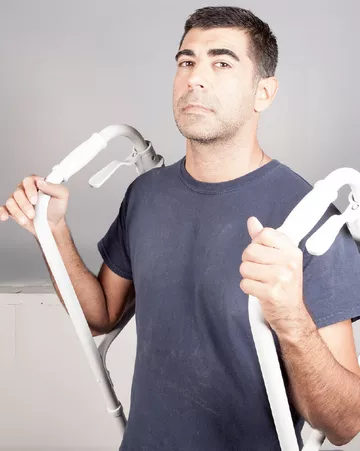
Shahryar Nashat:
Reverse Rorschach
The Tower
Studio 4, Level 2
From
to
Shahryar Nashat’s installation Reverse Rorschach (2023) stages the exhibition space as a real-time proxy for the artist’s emotional state through physiological variations.
Recorded by a monitoring device that the artist continuously wears throughout the duration of the presentation at LUMA Arles, his vital signs are interpreted by machine-learning algorithms and translated into images and sounds. Reverse Rorschach is facilitated by the text-to-image generator Imagen, which allows the evolving manifestations of Nashat’s physical and mental state to create Rorschach-like visuals. Rorschach testing was developed in 1921 by the eponymous Swiss psychiatrist to diagnose patients according to their interpretive responses to a series of abstract inkblot drawings. By using his psychophysiological data as a compositional tool, Nashat relinquishes the work of accessing his inner state—an effort traditionally associated with the artistic process—to directly impart it to the viewer. In turn, the viewer’s interpretation of the work is partially predetermined by the standard readings associated with Rorschach’s tests, Imagen’s anthropomorphizing inclinations, as well as a rapid succession of short illustrative sound pieces. Synced with the artist each minute of each day, Reverse Rorschach reveals further depths in the relationship between body and machine, while creating an ever-evolving, instantaneous self-portrait.
The exhibition is produced by the LUMA Arles & Google research initiative.
Shahryar Nashat
Shahryar Nashat (b. 1975) lives and works in Los Angeles. He has had solo shows at Art Institute Chicago (2023), Museum of Modern Art, New York (2020); SMK—Statens Museum for Kunst, Copenhagen, Denmark (2019); Swiss Institute, New York (2019); Kunsthalle Basel, Switzerland (2017); Portikus, Frankfurt, Germany (2016); Schinkel Pavillon, Berlin (with Adam Linder) (2016).
LUMA Arles & Google research initiative
In furtherance of LUMA’s long-term focus on the creative potential of innovation, LUMA Arles presents a series of three commissions by Shahryar Nashat, Rachel Rose, and Sara Sadik. Produced as part of a landmark research initiative in partnership with Google to leverage next-generation technology in service of artists’ visions, and developed over the course of a year with leading engineers, the three projects have embedded a wide range of advanced techniques in the fields of artificial intelligence, ambient sensors, colorimetry, biometrics, and human-machine interaction. Rather than an end in itself, innovation is harnessed as a means to further artistic expression, with artists interrogating the liminal space between digital presence, cognition and physical engagement. In exploring the creative edge of today’s most advanced technological tools, LUMA and Google seek to foster an artist-centric dialogue in fast-developing fields where original voices need to be amplified.
Organized by Simon Castets, Vassilis Oikonomopoulos, with Fabian Gröning.
The LUMA Arles & Google research initiative is organized in partnership with Google ATAP, Google Arts & Culture, and Google Brain by Camille Bénech-Badiou, with Gabriel Vergara II.
Thanks to Dr. Joelle Barral, Dr. Olivier Bau, Dr. Lucas Dixon, Dr. Kelly Dobson, Laurent Gaveau, Sebastien Missoffe, Dr. Ivan Poupyrev, Emily Reif, Amit Sood, Jonathan Tanant.
